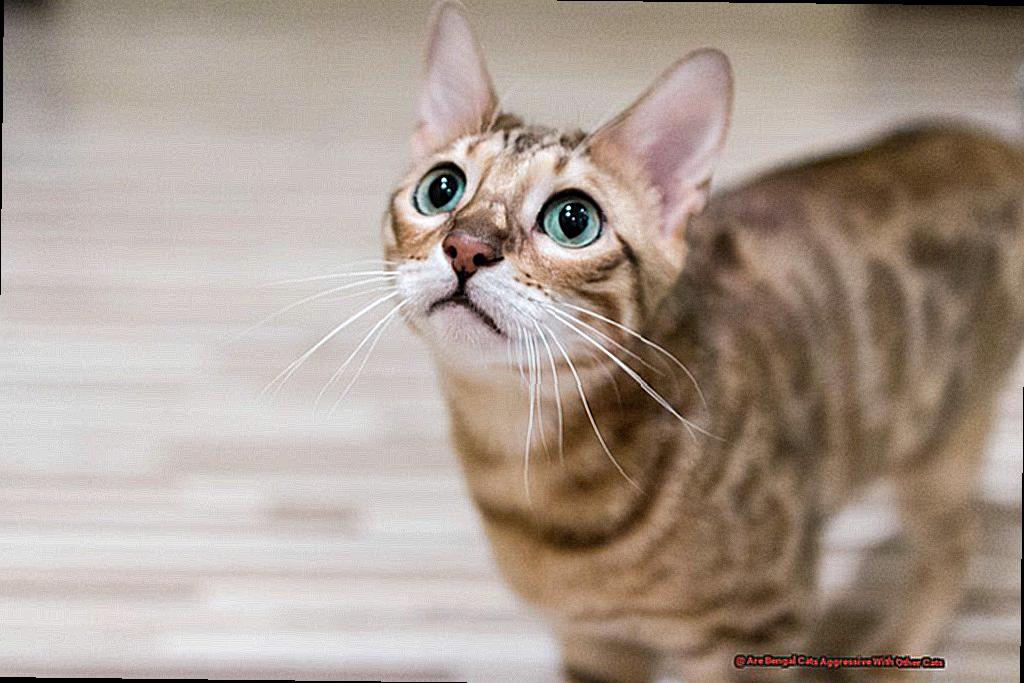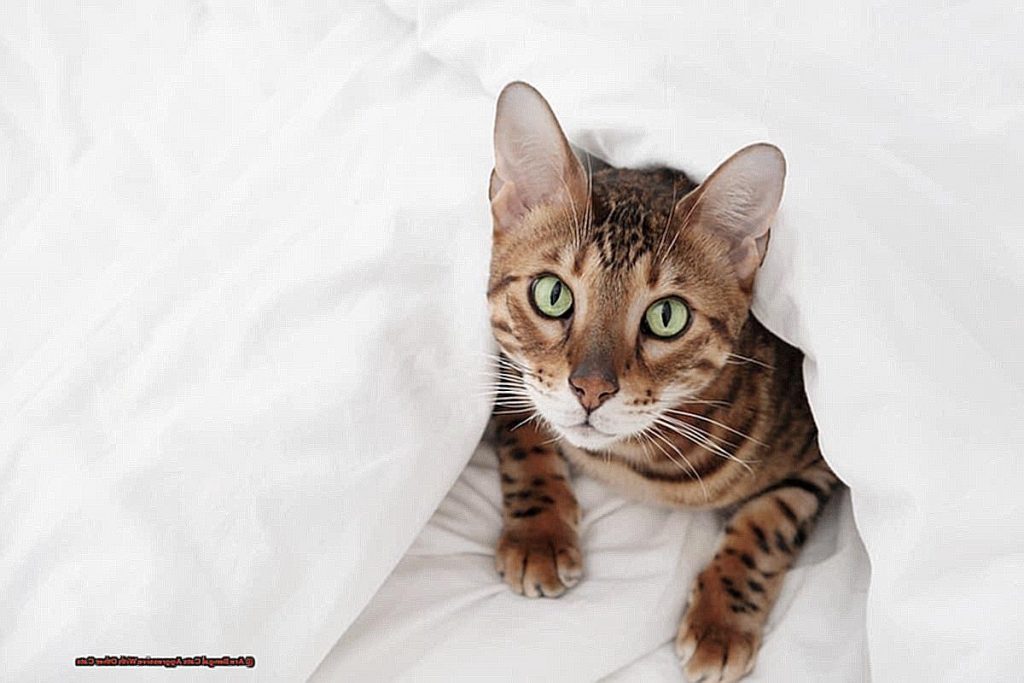Picture this: a sleek, spotted feline with piercing green eyes, prancing around your living room like a mini leopard.
That’s the beauty of owning a Bengal cat. But as much as we adore their wild looks and playful nature, there’s one question that often comes to mind – do they have a tendency towards aggression with other cats?
As someone who has shared my home with Bengal cats for years, I’ve seen firsthand the dynamic between these majestic creatures and their furry companions. So let’s dive into the world of Bengal cat behavior and discover how they interact with other cats.
Whether you’re a current owner or considering adding one to your family, this post will provide valuable insights on introducing them to other feline friends.
Are Bengal Cats Aggressive With Other Cats?
Contents
Firstly, it is important to understand that the answer to this question is not a simple yes or no. It depends on various factors, such as the individual personality of the Bengal cat, its socialization, and its environment. Let’s dive deeper into each of these factors to gain a better understanding.
Individual Personality:
Bengal cats are known for their exotic appearance and high energy levels, thanks to their wild ancestry. This can make them more prone to exhibiting aggressive behavior towards other cats. However, just like humans, each cat has its own unique personality. Some Bengal cats may be more territorial and exhibit aggressive behavior towards other cats, while others may be friendly and get along well with their feline companions.
Socialization:
Proper socialization is crucial for all breeds of cats, and this is especially true for Bengal cats. If they are not exposed to different environments and interact with other cats from a young age, they may become fearful or defensive around other felines. On the other hand, if they are raised around other cats from a young age, they are more likely to develop positive relationships with them.
Environment:
The environment also plays a significant role in how Bengal cats behave towards other cats. If they feel stressed or anxious due to lack of space or resources, they may exhibit aggressive behavior towards other felines. As responsible owners, it is our responsibility to provide a stress-free environment for our pets.
Tips for Preventing Aggression:
Now that we understand the factors that can influence aggression in Bengal cats, let’s talk about some tips for preventing it.
- Early socialization: As mentioned earlier, early socialization is key to ensuring a Bengal cat’s positive behavior towards other cats. If you have a Bengal kitten, make sure to expose them to different environments and interact with other cats.
- Training and discipline: Proper training and discipline are essential for all pets, including Bengal cats. By setting boundaries and providing appropriate outlets for their energy, Bengal cats can learn to coexist peacefully with their feline companions.
The Myth of Aggressive Bengal Cats
As a cat owner, you may have heard of the myth of aggressive Bengal cats. This misconception has caused many people to shy away from this beautiful and unique breed. However, the truth is that aggression is not a breed-specific trait and can be seen in any cat. In fact, Bengal cats are known for their friendly and sociable nature when raised in a loving and nurturing home.
So, where did this myth come from, and why does it still prevail among cat owners? Let’s take a closer look at the origin of this myth and debunk it once and for all.
Origins of the Myth
The belief that Bengal cats are aggressive may stem from the misconception that they are wild or hybrid breeds. However, this is simply not true. Bengal cats are domestic cats with no wild or hybrid ancestry. They were created by breeding a domestic cat with an Asian leopard cat, resulting in their beautiful coat patterns.
Another factor that may contribute to this myth is the idea that Bengal cats are more prone to aggression due to their “wild” appearance. However, there is no scientific evidence to support this claim. In fact, many Bengal cat owners describe them as affectionate and playful companions.
Factors That Contribute to a Cat’s Behavior
It’s essential to understand that many factors contribute to a cat’s behavior, such as genetics, environment, and socialization. These factors play a significant role in shaping a cat’s personality and temperament.
Responsible Breeding and Proper Training
Like any other breed, the temperament of a Bengal cat is influenced by responsible breeding and proper training. It’s crucial to choose a reputable breeder who prioritizes the health and well-being of their cats. A responsible breeder will ensure that their cats are well-socialized and have a friendly and gentle demeanor.
Additionally, proper training can help prevent unwanted behaviors in any cat, including Bengal cats. Early socialization, positive reinforcement, and consistency are key in shaping a cat’s behavior.
Introducing Bengal Cats to Other Feline Companions
One common misconception is that Bengal cats cannot get along with other cats. However, this is not true. With proper introductions and gradual acclimation, Bengal cats can coexist peacefully with other feline companions. It’s essential to provide each cat with their own space and resources to avoid potential territorial behaviors.
Factors That Contribute to Aggression in Bengal Cats
Bengal cats are a unique and exotic breed known for their stunning appearance and playful personality. However, like any other cat breed, they can also exhibit aggressive behaviors towards other cats. As responsible cat owners, it is important to understand the potential factors that can contribute to aggression in Bengal cats and how to address them.
High Energy Levels: A Common Culprit
One of the main factors that can contribute to aggression in Bengal cats is their high energy levels. These cats are a hybrid of domestic cats and Asian leopard cats, which are known for their high activity levels and hunting instincts. This means that Bengal cats have a lot of excess energy that needs to be released through play and exercise.
When this energy is not properly channeled, Bengal cats can become frustrated and resort to aggressive behavior towards other cats. This is especially common in multi-cat households where the Bengal may feel the need to establish dominance or protect their territory. As an owner, it is important to provide your Bengal with plenty of opportunities for play and exercise to release their energy in a healthy way.
Lack of Proper Socialization: The Importance of Early Socialization
Another factor that can contribute to aggression in Bengal cats is lack of proper socialization. Socialization is crucial for all cats, but it is especially important for Bengal cats due to their wild ancestry. If they are not properly socialized from a young age, they may be more prone to exhibiting aggressive behaviors towards other cats.
As a responsible owner, it is important to introduce your Bengal kitten to various people, animals, and environments from a young age to ensure they are comfortable and confident in different situations. This will help prevent potential aggressive behaviors in the future.
Environmental Factors: Competition for Resources
In a household with multiple cats, limited resources such as food, water, or litter boxes can lead to competition and potential aggressive behavior. As natural hunters, Bengal cats may feel the need to protect their resources and may exhibit aggressive behaviors towards other cats who try to access them.
To prevent this, it is important to provide enough resources for each cat in the household and ensure they are placed in different areas to avoid competition.
The Importance of Socialization for Bengal Cats
Bengal cats are a unique and fascinating breed, known for their striking markings and energetic personalities. As an expert on these wild-looking felines, I can attest to the fact that proper socialization plays a crucial role in their development. In this post, I will delve into the importance of socialization for Bengal cats and how it helps them become confident and well-adjusted individuals while preventing aggressive behavior towards other cats.
Socialization is the process of exposing a cat to different people, animals, and environments during their early development. This allows them to learn how to adapt and interact with others in a positive manner. For Bengal cats, who have a wild ancestry, proper socialization is crucial to prevent aggressive behavior towards other cats.
Bengal cats are a hybrid breed created by crossing domestic cats with wild Asian leopard cats. Due to their wild ancestry, they may exhibit aggressive behaviors towards other cats if not properly socialized. By exposing them to different people and animals from a young age, Bengal cats learn to be friendly and comfortable around others.
The key is to start socializing your Bengal cat from a young age. This includes exposing them to different cats and animals, as well as people of all ages, genders, and races. It is important to do this in a safe and controlled environment to prevent any potential harm.
Continuing socialization throughout a Bengal cat’s life is also essential. This can include taking them on walks or outings to meet new people and animals, as well as providing positive reinforcement when they display friendly behavior towards other cats.
If a Bengal cat is not properly socialized, they may become fearful or aggressive towards other cats. This could lead to fights and injuries, which can be dangerous for both the cats involved and their owners. It is important to address any signs of aggression early on and seek professional help if needed.
Introducing a new cat to a household with existing Bengal cats should also be done slowly and carefully to prevent any potential aggression. It is crucial to monitor their interactions and provide positive reinforcement when they display friendly behavior towards each other.
Tips for Introducing Bengal Cats to Other Felines
Introducing a new cat to an established household can be a challenging task, especially when dealing with a potentially aggressive breed like the Bengal. But fear not, with proper preparation and thoughtful introductions, Bengal cats can learn to coexist peacefully with other cats. As an expert on introducing Bengal cats to other felines, I have gathered some tips to help you make this process smoother for both you and your fur babies.
First and foremost, it is crucial to understand that every cat is unique and may react differently to introductions. Therefore, it is essential to take things slow and provide a structured and controlled environment for the cats to get to know each other. Before introducing your Bengal cat to other felines, make sure your Bengal is well-socialized and has been exposed to other cats in a positive way. This will help them understand and respect feline body language and communication cues.
It is also important to have a separate space for each cat during the initial introduction period. This could be a spare room or a designated area of the house where each cat can have their own food, water, litter box, and toys. This will prevent any territorial disputes and allow the cats to become accustomed to each other’s scents before meeting face-to-face.
When it is time for the cats to meet, make sure they are both in a calm state. It may be helpful to have another person present to assist with the introduction and intervene if necessary. Keep initial interactions short and supervised, gradually increasing the amount of time they spend together as they become more comfortable with each other.
Remember to reward good behavior with treats and praise, while also redirecting any negative behaviors with positive reinforcement techniques. If there are any signs of aggression or tension, separate the cats and try again later. It may take several attempts before they are able to coexist peacefully.
It is also important to understand that Bengal cats may exhibit aggressive behavior towards other cats due to their high energy level and strong hunting instincts. Proper socialization and providing enough mental and physical stimulation through playtime and environmental enrichment activities can help prevent this behavior.
Managing Aggressive Behavior in Bengal Cats
Bengal cats are known for their high energy levels and playful nature, but sometimes this can manifest into aggressive behavior towards other cats. As a cat owner, it is important to understand and manage this behavior to ensure a peaceful and happy household. In this blog post, we will discuss some effective strategies for managing aggressive behavior in Bengal cats based on research and personal experience.
Proper Socialization
One of the key ways to prevent and manage aggressive behavior in Bengal cats is through proper socialization from a young age. This involves exposing them to different environments, people, and animals in a controlled and positive manner. By doing so, Bengal cats learn how to interact with others and become more accepting of new situations. This can also help them develop confidence and reduce fear-based aggression.
Mental and Physical Stimulation
Bengal cats are highly active and intelligent creatures that require plenty of mental and physical stimulation. Boredom or lack of stimulation can lead to aggressive behavior as a way for them to release pent-up energy. To prevent this, make sure your Bengal cat has access to interactive toys, puzzle games, and scratching posts. Regular playtime is also essential for keeping them physically active and mentally stimulated.
Establishing Rules and Routines
Creating a structured environment with clear rules is crucial for managing aggression in Bengal cats. This helps them understand boundaries and expectations, reducing the likelihood of aggressive outbursts. Consistency is key when it comes to enforcing rules and routines. For example, if you do not allow your cat on the kitchen counter, make sure this rule is consistently enforced.
Seek Professional Guidance
If your Bengal cat’s aggressive behavior persists despite your efforts, it may be beneficial to seek professional guidance from an animal behaviorist. They can assess the situation and provide tailored advice on managing the behavior. Remember that every cat is unique, so what works for one may not work for another. A professional can provide personalized guidance to help you and your cat.
Avoid Punishment
Punishment or physical force should never be used as a means of managing aggression in Bengal cats. This can worsen the behavior and damage the bond between the cat and its owner. Instead, focus on positive reinforcement techniques, such as rewarding good behavior and redirecting negative behavior.
Creating a Peaceful Environment for Multiple Bengal Cats
Are you the proud owner of not just one, but multiple Bengal cats? Congratulations on having double the fun and love in your life. But as a fellow Bengal cat owner, I know that living with these wild and energetic creatures can also come with its challenges. In particular, creating a peaceful environment for multiple Bengal cats can be a bit of a task. But fear not, as I am here to share my personal experiences and valuable tips on how to achieve harmony among your furry friends.
Introducing New Cats
Bengal cats are known to be territorial and may exhibit aggression towards other cats, especially when a new cat is introduced into their environment. The key here is to take things slow and give them time to adjust. Start by keeping the new cat in a separate room for a few days, allowing them to get used to each other’s scents through a closed door. Gradually increase their interaction time and always supervise their interactions until you are confident that they have accepted each other.

Providing Enough Space
Bengal cats are highly active and need plenty of space to roam and play. When multiple Bengal cats are living together, it is crucial to provide enough space for each cat to have their own territory. This will not only prevent any potential conflicts over territory but also allow each cat to have their own personal space when needed.
Placing Multiple Resources
Cats can become aggressive when resources such as food, water, and litter boxes are limited. To avoid this, make sure to have multiple resources placed in different areas of the house, so each cat has access to them without having to compete with other cats. This will also help prevent any dominant behaviors over resources.
Using Positive Reinforcement
Positive reinforcement techniques can be highly effective in promoting peaceful interactions between Bengal cats. Rewarding good behavior with treats or praise can help establish a positive association between the cats and create a harmonious relationship. On the other hand, avoid using punishment or scolding as it can lead to fear and aggression among the cats.
Providing Hiding Spots
Just like humans, cats need their own personal space too. In a multi-cat household, it is important to provide hiding spots such as cat trees, shelves, or boxes where each cat can retreat to when they feel overwhelmed or stressed. This will help reduce any potential conflicts and give each cat a sense of security.
Conclusion
In conclusion, Bengal cats bring a unique blend of wild beauty and playful energy into any household. However, like any breed, their behavior towards other cats can be influenced by various factors. As a proud Bengal cat owner and through extensive research, I have discovered that the answer to whether they are aggressive with other cats is not a simple yes or no.
A Bengal cat’s personality, socialization, and environment all play a crucial role in shaping their behavior towards other felines. It is essential for owners to understand these factors and take necessary precautions to prevent potential aggression.
Contrary to popular belief, the myth of aggressive Bengal cats has been debunked. Responsible breeding and proper training are key in shaping their temperament. With early socialization, positive reinforcement techniques, and enough mental and physical stimulation, Bengal cats can learn to coexist peacefully with other feline companions.
When introducing Bengal cats to each other, it is important to do so gradually and in a controlled environment. Providing each cat with their own space and resources helps avoid conflicts over territory. Seeking professional guidance may also be beneficial if aggression persists despite efforts from the owner.
Creating a peaceful environment for multiple Bengal cats requires careful consideration of their individual needs. Providing enough space, resources, hiding spots, and using positive reinforcement techniques can promote harmony among these majestic creatures.
As responsible owners, it is our duty to ensure that our beloved pets are well-socialized and provided with a stress-free environment.






